Margaret Cross, B.Sc. Honors in Palaeontology and Ashley Johnson, Education and Outreach Coordinator
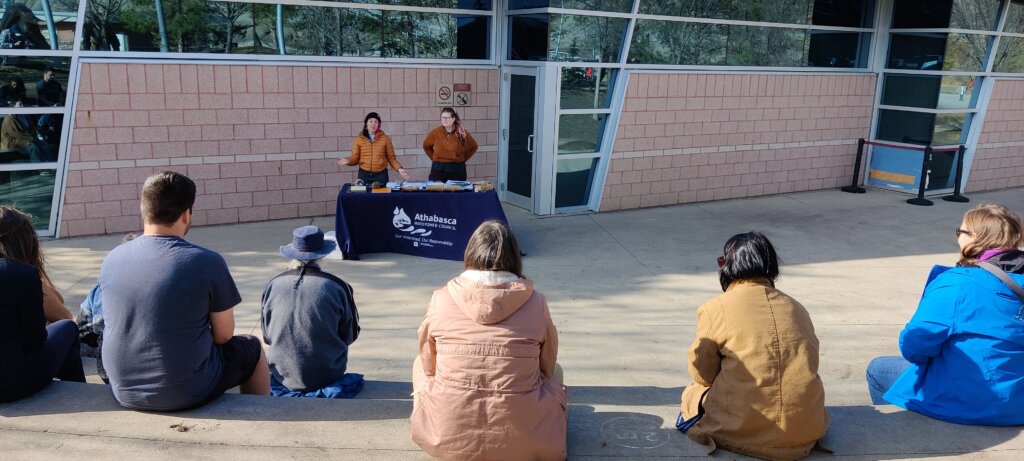
In October, Margaret and Ashley gave a talk to the WPAC summit attendees who came to the Royal Tyrrell Museum on palaeontology. We’ve modified the talk to fit into this blog format.
Indigenous Acknowledgment
Our province has a rich and diverse history, and we understand and recognize that the fossils we study are not only important to the pursuit of scientific inquiry and knowledge, but are also part of the spiritual history of groups including the Blackfoot and Cree, who have stewarded these sacred lands for many generations.
Fossil Collection Guidelines in Alberta
Alberta’s fossils are protected under the Government of Alberta’s Historical Resources Act, which protects the province’s palaeontological sites, structures, and objects. Excavation of fossils in Alberta without proper permits is illegal, as is any form of collection within provincial parks and other protected areas. If you find a fossil in a park or protected area, or embedded in the ground, you can take pictures, record GPS coordinates and any important landmarks and turn the information into the Royal Tyrrell Museum. Palaeontologists use not only fossils, but the rock surrounding them and the positioning of them within the earth to form a complete picture. On public land, or private land with permission, you can collect any fossils you find sitting on the surface and take them home, but it is illegal to take them out of the province as Alberta’s fossils belong to her and her people.
Geology
Alberta has a rich geological history, and the Athabasca watershed is an excellent example. In the northeast, we have a small portion of the Canadian Shield, whose age ranges from 2.5 to 4.2 BILLION years old! The Fort McMurray Oil Sands have produced some incredible fossil discoveries, some of which are on display at the Royal Tyrrell Museum like the charismatic Borealopelta markmitchelli (pictured below).
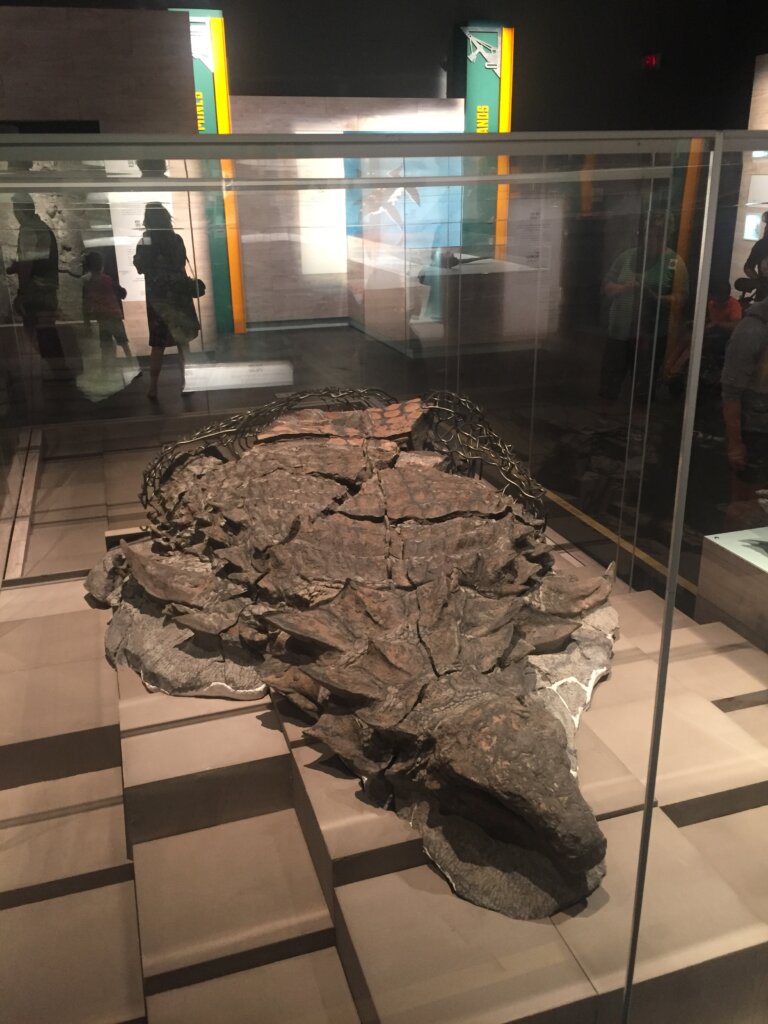
Many of those discoveries are from early Cretaceous rocks, from when Fort McMurray was part of the Western Interior Seaway. Drumheller, in the Red Deer River Watershed, is famous for its dinosaur bones which mainly come from late Cretaceous rocks, mainly Horseshoe Canyon Formation.
So, where do these rocks come from? How did they form? During the Cretaceous, Fort McMurray would have been underwater, and Drumheller’s stratified hills would have been floodplains, rivers, and swamps. We can tell the environment from indicators like grain size (smaller grain sizes are indicative of slow moving or still water, like lakes and swamps; larger grains tell us the water was moving faster, powerful enough to carry larger sediments like in rivers and flood events).
Brief Dinosaur Tangent & What is a fossil?
The Horseshoe Canyon Formation yields a number of dinosaurs from groups including ankylosaurs, ceratopsians, pachycephalosaurs, hadrosaurs, and of course tyrannosaurs like the charismatic Albertosaurus, and many more.
Before we talk more about fossils, first we have to define what a fossil is! A fossil is the remains of any living organism preserved in the rock record.
How do fossils form?
- The organism dies.
- Against all odds of being scavenged and/or decaying to the elements the organism must be quickly buried, usually by water carrying sediment over and depositing on top of the remains, cocooning them in sediment.
- Over time, new layers of sediment are deposited, slowly replacing organic material with minerals or preserving the shape of where an organism once lay. The replacement of organic material often occurs through the process of permineralization, which is a type of fossilization where minerals (usually transported by water) permeate into the sediment and decaying remains, effectively recrystallizing them.
There are different types of fossils, including but not limited to:
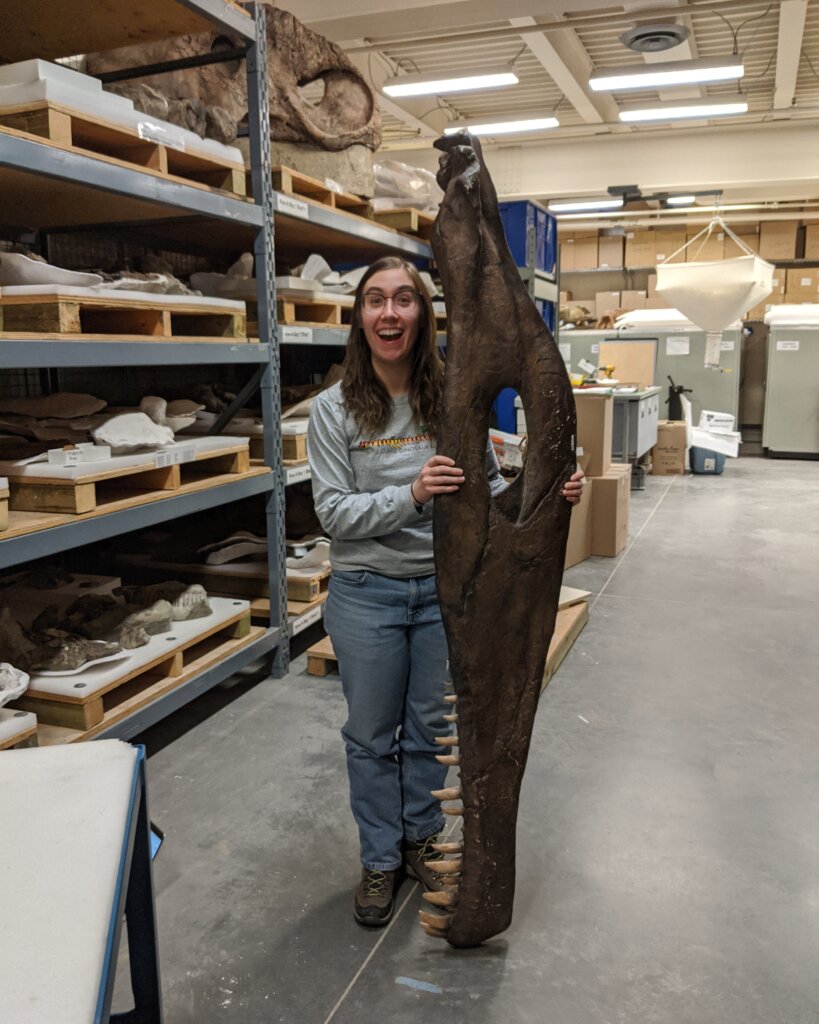
Body Fossils (whole/parts of the organism). The majority of the bones in the photo above are body fossils. Ashley is holding a cast (a plaster replica) of a Giganotosaurus mandible (lower jaw bone).
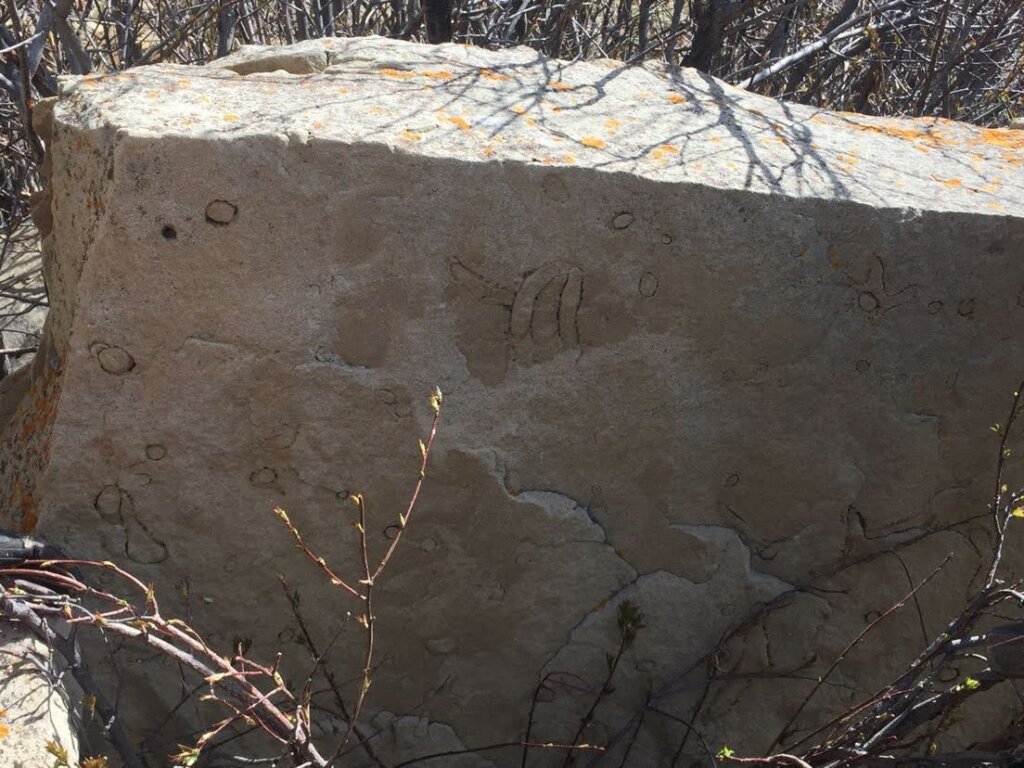
Trace Fossils (footprints and burrows). Trace fossils can be a bit trickier to spot, but the shrimp burrows above shouldn’t be too hard to spot!
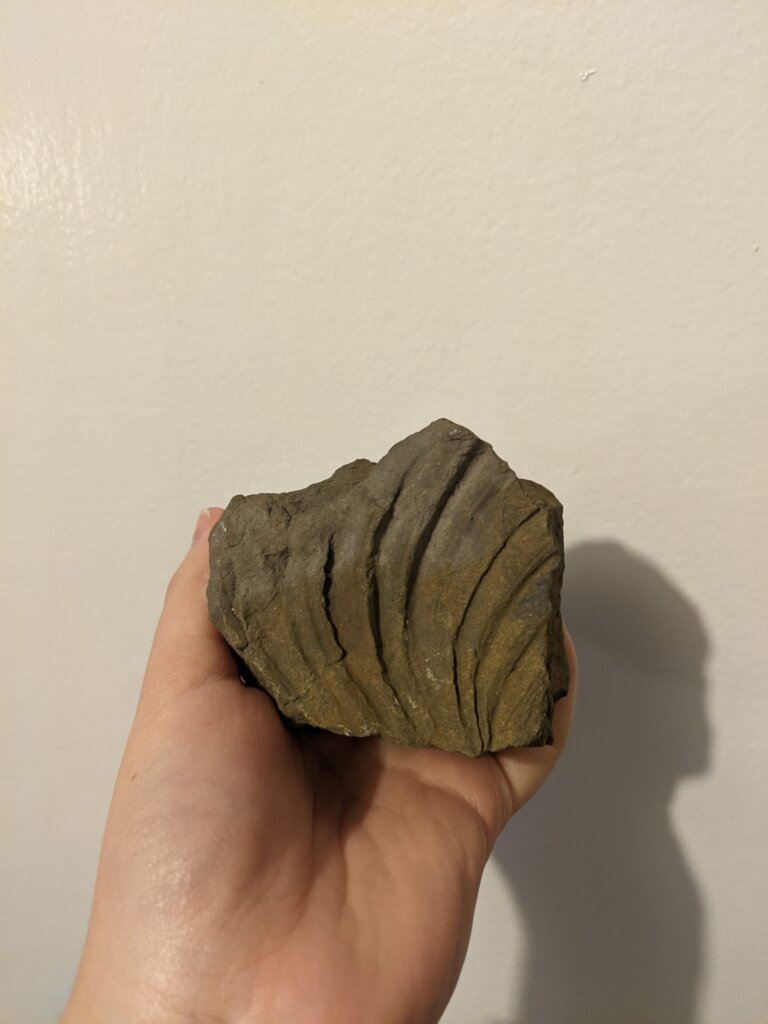
Casts and Molds (a mold is an impression left by an organism in sediment; a cast occurs when sediment fills an impression when the original fossil decays/erodes away). The photo above is a fossilized mold of a clam, but it looks just like someone pressed a clam into some sand.
Marine Palaeontology
Dinosaurs are cool, but that’s not all the fossil record has to offer. There are a variety of organisms that shared the land with the dinosaurs, and in some cases still have modern representatives that live in Alberta today. Horseshoe Canyon yields a number of marine reptiles, amphibians, and fish species such as champsosaurs (crocodile-like lizards), Myledaphus (a ray-like mollusc eating fish with very distinctive, boxy teeth), and while modern Alberta is home to only one species of native turtle (the Western Painted Turtle), cretaceous Alberta supported a number of turtle species including soft-shelled turtles!
Just as in modern ecosystems, relative abundance of certain organisms can give us clues as to what is going on with the environment. A rarity of turtles in the Horseshoe Canyon formation for example can indicate that temperatures were cooler, allowing less range for ectothermic (cold-blooded) organisms like turtles, salamanders, lizards, etc.
Conservation and Palaeontology
Palaeontology is cool (and there are enough dinosaur movies to prove it), but did you know it’s also applicable to modern conservation? The field of conservation palaeobiology looks at applying palaeontological knowledge to modern environmental science, with the goal to leverage our past to better understand our future. Our world has a history of global change, with a rich record of how organisms are impacted by a shifting climate. Granted, none of the changes have been on this scale before, but there are still ways for our fossil record to inform modern conservation.
A large body of academic research has emerged applying paleontology to modern problems, including integrating history, palaeobiology and archaeology for the conservation of Chesapeake Bay (Rick & Lockwood 2012), using the palaeontological record to inform extinction risk (Finnegan et al. 2023), as well as looking at modelling climate refugia (Gavin et al. 2014; Morelli et al. 2016; Schneider 2018).
Palaeontology and Water Management
Recent research by Barbieri et al. (2020) has used micropalaeontology to help define reference conditions on the Po Coastal Plain in Italy, and closer to home Dr. Savarese and his graduate student at Florida Gulf Coast University had used conservation palaeoecology to inform water release practices on the Caloosahatchee River. The same researcher also worked on a restoration project using oyster assemblages as a proxy for salinity to inform hydrologic restoration in the Picayune Strand (Savarese 2018).
A topic of particular interest to the Athabasca watershed is applying a palaeolimnological perspective. By taking sediment cores from lake bottoms, we unlock a rich record that can help us establish targets for mitigation. Some of the applications of palaeolimnology include answering questions about whether human activities are causing an increased impact on water quality. Like much of paleontology, this is done through proxy information: chironomids (a common benthic invertebrate) can be used as a proxy for understanding deep water oxygen levels in lakes; lower biodiversity in some cores can indicate more human influence; sediment cores can be used to track species introductions, fish populations, and even climate change (Smol 2017).
Further Reading
The Time Scavengers, a non-profit organization that aims to increase the accessibility of science to the public, wrote an excellent blog about the Fossils of Alberta.
Alberta’s oldest plesiosaur fossil found at Mildred Lake oilsands site
Citations
Barbieri, G., Rossi, V., Ghosh, A. and Vaiani, S.C., 2020. Conservation paleobiology as a tool to define reference conditions in naturally stressed transitional settings: Micropaleontological insights from the Holocene of the Po coastal plain (Italy). Water, 12(12), p.3420.
Finnegan, S., Harnik, P.G., Lockwood, R., Lotze, H.K., McClenachan, L. and Kahanamoku, S.S., 2023. Using the Fossil Record to Understand Extinction Risk and Inform Marine Conservation in a Changing World. Annual Review of Marine Science, 16.
Gavin, D.G., Fitzpatrick, M.C., Gugger, P.F., Heath, K.D., Rodríguez‐Sánchez, F., Dobrowski, S.Z., Hampe, A., Hu, F.S., Ashcroft, M.B., Bartlein, P.J. and Blois, J.L., 2014. Climate refugia: joint inference from fossil records, species distribution models and phylogeography. New Phytologist, 204(1), pp.37-54.
Morelli, T.L., Daly, C., Dobrowski, S.Z., Dulen, D.M., Ebersole, J.L., Jackson, S.T., Lundquist, J.D., Millar, C.I., Maher, S.P., Monahan, W.B. and Nydick, K.R., 2016. Managing climate change refugia for climate adaptation. PLoS One, 11(8), p.e0159909.
Rick, T.C. and Lockwood, R., 2013. Integrating paleobiology, archeology, and history to inform biological conservation. Conservation Biology, 27(1), pp.45-54.
Savarese, M., 2018. Effectively connecting conservation paleobiological research to environmental management: examples from Greater Everglades’ restoration of southwest Florida. Marine conservation paleobiology, pp.55-73.
Schneider, C.L., 2018. Marine refugia past, present, and future: Lessons from ancient geologic crises for modern marine ecosystem conservation. Marine conservation paleobiology, pp.163-208.
Smol, J.P., 2017. Conservation biology and environmental change: a paleolimnological perspective. Conservation paleobiology: Science and practice, pp.31-43.